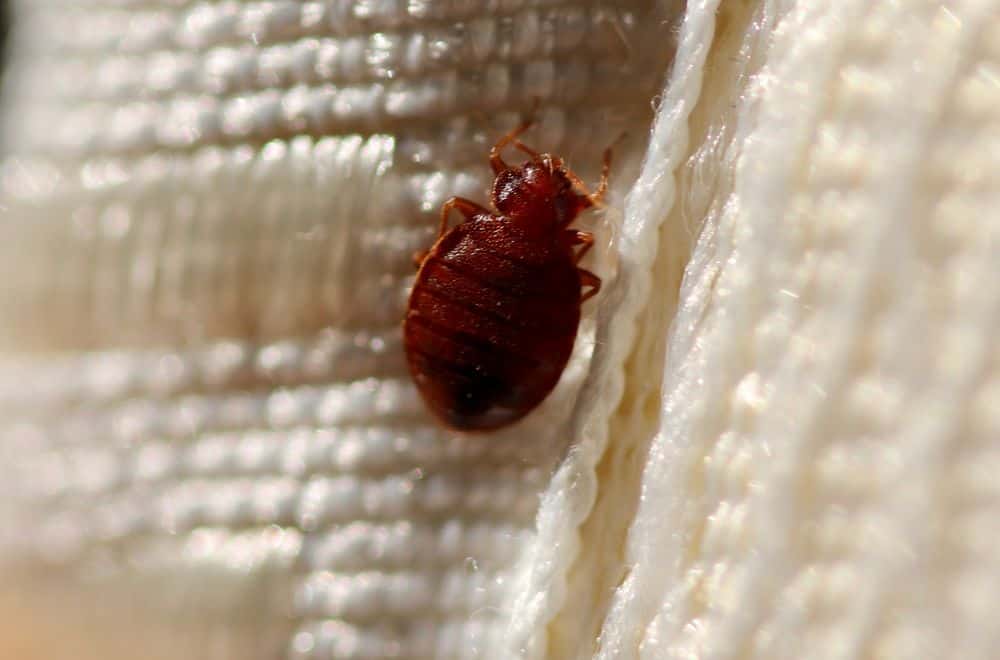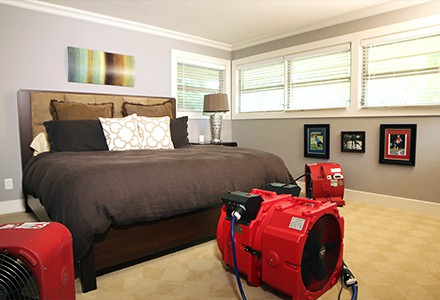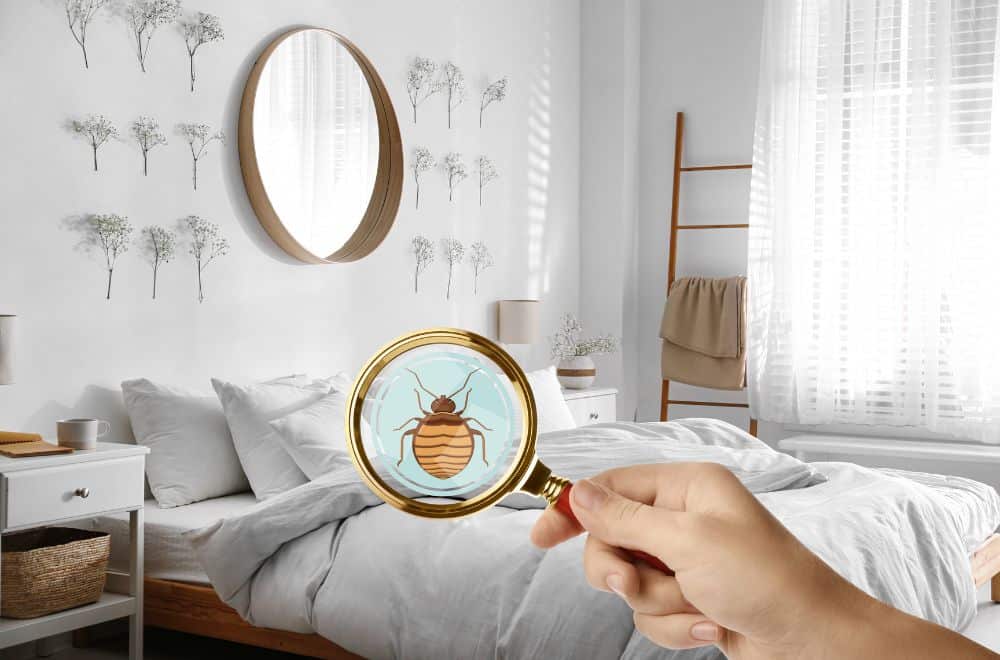Bedbugs are some of the trickiest pests to get rid of. This is because they can go up to a year without food then spring back to life once a warm body approaches! Online searches offer tons of DIY tips and tricks to destroy these tiny vampires. But do bedbug heat treatments work? Let’s take a closer look to test this pest management option and a few others as well.
Identifying Bedbugs
Bedbugs are tiny crawlers that are typically 4mm to 5.5mm in adult form. Their nymphs go through several life stages and molt multiple times between hatching and adulthood. A bedbug egg is off-white to yellow while a nymph is beige or tan, but gets distinct red portions in its belly after meals. Adult bedbugs are reddish-brown with a striped body and antennae.
Bedbugs look similar to their cousins – bat bugs and swallow bugs. These insects are almost identical, but their bodies are hairy, their antennae are slightly different, and their coloring is closer to grey than brown. These swallow bugs and bat bugs attack birds and bats, so you’ll find them closer to the ceiling and will see a swallow nest or bat habitat somewhere nearby.
Swallow bugs and bat bugs are also smaller than bedbugs, and won’t bite humans unless their preferred host (i.e. birds and bats) are unavailable. But all these insects have a tiny head, a small thorax, and a massive abdomen with jointed legs. Their oval bodies are flat so they can slip into narrow spaces, but they bulge out a little after trips to their blood buffet.
Bedbugs and their blood-sucking cousins can ‘hibernate’ during low-blood periods then revive their lifestyle once they find a new host. This is why they keep coming back. A house can be empty for months then the moment someone moves in or even visits to inspect the property, the dormant bedbug will hop on, grab a quick snack, and revamp its family tree.
But for the record, bedbugs don’t cause diseases. Their bites are painless, but they can cause rashes, inflammation, and allergies. They’re highly contagious though. Plus, the idea of them crawling all over you, those dark spots on your sheets, and the possibility of passing them to neighbors and houseguests is a nightmare in itself. And they can sometimes cause anemia.
The Bedbug Lifecycle

Female bedbugs need blood before they can lay eggs, so they have a huge meal then lay 1 to 5 eggs every day. Plus, she needs a fresh meal every three or four days, so she can lay up to 500 eggs in her lifetime. These eggs take 6 to 10 days to hatch. Once they hatch into nymphs, they will molt about 6 times before they become adults, a process that takes roughly 10 weeks.
Bedbug eggs measure about 1mm and each stage grows by about half a millimeter. The last two molts have the biggest growth spurts, usually 1mm to 1.5 mm so a fully grown bedbug is 5.5mm. Before each molt, a bedbug nymph needs one or more blood meals. It then takes a week or so to shed its exoskeleton. It could take longer if warm blood isn’t readily available.
Once the bedbugs reach adulthood, they still need to feed every few days. But if they don’t find a host, they can stay dormant for 10 months to a year on a full stomach. When they eventually feed, they resume laying eggs and create a new generation of bedbugs. Feeding sessions don’t take long, since bedbugs only need 3 to 12 minutes to fill their tiny tummies.
Bedbug bites don’t hurt so you’re unlikely to react or swat them away. But you might still feel them crawling on your skin, so it helps if you’re immobile. That’s why bedbugs mostly feed at night. They use carbon dioxide and bio-signals to find you in the dark. And since they don’t fly and can only travel one foot a day, they’d rather live and breed in your bed, close to food.
That said, bedbugs have flattened bodies so they can squeeze into seams and cracks. You can find them in upholstery couches, carpets, wallpaper, rugs, clothing, floorboards, suitcases, and even wall crevices. You could easily pick one up on a bus or movie hall and bring it back home. If they have a constant food source, bedbugs can live for 6 to 12 months on average.
Does Heat Work on Bedbugs?

Image Credit: peerlessrestoration
Yes. Heat is the most effective bedbug killer because it destroys eggs, nymphs, and adults, as well as any dormant sleeper agents. But it’s not a permanent solution since new colonies of bedbugs can still make their way into your home. That said, heat is a versatile pest treatment option, and that’s part of its popularity for long-term management. Techniques include:
- Steaming bedbug sites then vacuuming the debris.
- Steaming your luggage after trips to avoid bringing bedbugs home.
- Washing infested fabrics in extremely hot water.
- Using a hot dryer for any bedbugs that didn’t die in the wash.
- Using a dry-heat machine in rooms where bedbugs live.
You can introduce dry heat with a portable heat chamber. A home heater won’t do, because you need 113°F (45°C) for at least 90minutes, or 118°F (48°C) for 20 minutes to half an hour. The temperature must be constant, so a fluctuating home heater with a built-in thermostat isn’t effective. You also need a heat source that won’t damage your furniture and other items.
For a household dryer, you’ll need to keep the items in for at least 30 minutes on high. This is helpful for sheets, blankets, duvets, throw rugs, shoes, small cushions, pillows, and stuffed toys. Don’t overstuff the dryer though, since the hot air needs to circulate freely. You may need to vacuum the dryer with a hose attachment to extract all that dead bedbug debris.
Some of your items can’t go in the tumble dryer, so you can use a clothes dryer with built-in shelves. But since your stuff won’t be tossed around, you may need longer treatment times. Read the labels carefully to be sure the heat won’t damage your items. Books, bags, tools, and heatproof plastic e.g. ornaments and picture frames can be safely de-bedbugged this way.
Why Heat Works on Bedbugs
The advantage of heat over pesticides or residual treatments is that humans and pets can safely enter the room once the heat is off. With other options, you may have to avoid the area for 2 days or more. Professional steam treatments are popular for mattresses, rugs, carpets, and couches. You can point them at baseboards or wallpaper but you risk moisture damage.
Exterminators set their steam pipes at 160°F to 180°F (71°C to 82°C). They typically move along the target at 2 feet per minute to ensure they kill everything. This can get expensive since they bill by the hour. Plus, they may have to follow up by vacuuming all the steamed spots to pull out the dead-bug residue, pun intended. Steam velocity is a key factor as well.
If the steam moves too fast, it’ll just blow the bedbugs deeper into their hiding spots instead of killing them. Or it may shift them to other parts of the room where they can escape and spread. If you’re handy, you can construct a DIY steam chamber and place infested items in it. But that still leaves the bedframe, couch, and baseboards exposed, so they need steamers.
| Heating Equipment | Type
of Heat |
Target Temperature | Minimum Treatment
Duration |
| Clothes Dryer
with Shelves |
Dry Heat |
High
(113°F to 118°F) (i.e. 45°C to 48°C) |
45 Minutes |
|
Tumble Dryer |
Dry Heat |
High
(113°F to 118°F) (i.e. 45°C to 48°C) |
30 Minutes |
| DIY Steam Chamber | Wet Heat | 120 °F (49°C) | 2 to 4 Hours |
| Steam Hose | Wet Heat | 160°F to 180°F
(71°C to 82°C) |
24 Inches Per Minute |
| Professional Heating System e.g. ThermaPure, Temp-Air |
Dry Heat |
115°F to 135°F (46°C to 57°C) |
6 to 8 Hours Including Set-Up and Pack-Up |
| Portable
Duffel Bag Steamer e.g. PackTite |
Wet Heat |
120°F (49°C) |
2 to 4 Hours with Automatic Timer |
When you use a heating system that fills the whole room, convection fans push the hot air all around the room. For dry heat, set a maximum temperature of 135°F (57°C), since anything higher than that might damage your electronics. Also, for steam treatments, you may need to remove and/or insulate any furnishings and accessories that can be damaged by moisture.
Other Options for Getting Rid of Bedbugs
Two popular options for getting rid of bedbugs are vacuum cleaners and diatomaceous earth. They can be effective but are quite cumbersome because you have to vacuum every single spot and/or sprinkle the DE as a follow-up. It takes roughly 48 hours for diatomaceous earth to kill a bedbug, and you’d have to be sure you reached every corner or they’ll just run away.
Professional exterminators will do a better job of getting into those hidden spots where bedbugs may be hiding. You’ll need multiple sessions to vacuum the eggs, casings, and remnants of the bedbugs after the DE kills them. Pesticides are a go-to for lots of people, but bedbugs feed on our blood so they’re resistant to the insecticides toxins we’re exposed to.
The best way to get rid of bedbugs for good is to combine multiple treatment options. Start with heat, which will scorch all the pests to bits. This can be steam or dry heat, based on your needs, resources, and targets. Then, vacuum the area to remove any remnants. Finally, use a residual treatment like DE or a pesticide safe for pets, kids, and other household residents.
Top Bedbug Tips
- Wash thrifted furniture, clothes, garage sale finds, etc. in boiling water.
- Don’t switch sleeping spots – you’ll only spread the infestation.
- Place bedbug detectors under the feet of your bed for monitoring purposes.
- After treatment, use a bedbug mattress case for 18 months to starve them in.
- Check online reviews – they sometimes mention infested hotels and motels.
Do you know any other methods for bedbug management? Tell us in the comments section!
